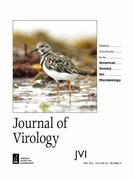Persistent high-risk human papillomavirus (HR-HPV) infection is an important factor in the development of cervical cancer, and human papillomavirus type 16 (HPV-16) is the most common HR-HPV type worldwide. Th… Continue reading on BioMed Central
Tag: Oncogenic Viruses
Bridging the Gap: Immunotherapy in Progressive Multifocal Leukoencephalopathy: A New Hope?
AI SummaryProgressive multifocal leukoencephalopathy (PML) is a severe infection of the CNS caused by the JC virus. There is currently no effective antiviral treatment for PML, so boosting the immune response against the virus is important. A case is presented where a patient with PML after kidney transplantation received recombinant human interleukin 7 to enhance… Continue reading Bridging the Gap: Immunotherapy in Progressive Multifocal Leukoencephalopathy: A New Hope?
Unveiling the role of EBV in the onset and progression of multiple sclerosis
AI SummaryAn international research team is investigating the connection between the Epstein-Barr virus (EBV) and the development of multiple sclerosis (MS). They aim to understand why only some EBV-infected people develop MS, and to uncover the underlying mechanism. The team is conducting clinical trials to test antiviral therapies and will analyze blood and saliva samples.… Continue reading Unveiling the role of EBV in the onset and progression of multiple sclerosis
Direct interaction with the BRD4 carboxyl-terminal motif (CTM) and TopBP1 is required for human papillomavirus 16 E2 association with mitotic chromatin and plasmid segregation function
AI SummaryThe text discusses the functions of the papillomavirus E2 protein, including its role in regulating viral replication, transcription, and plasmid segregation. The text also mentions the interaction between the E2 protein and host proteins during mitosis. Further research is needed to understand the plasmid segregation function of the E2 protein in human papillomavirus 16.INTRODUCTIONPapillomavirus… Continue reading Direct interaction with the BRD4 carboxyl-terminal motif (CTM) and TopBP1 is required for human papillomavirus 16 E2 association with mitotic chromatin and plasmid segregation function
The effect of hepatitis B virus on the risk of pregnancy outcomes: a systematic review and meta-analysis of cohort studies
AI SummaryThis text discusses the impact of chronic hepatitis B virus on neonatal and maternal outcomes and aims to determine its effect through a meta-analysis.The effect of HBV on neonatal and maternal outcomes can create a basis for more accurate clinical decision-making. So, the aim of this meta-analysis is to detrmine the effect of chronic… Continue reading The effect of hepatitis B virus on the risk of pregnancy outcomes: a systematic review and meta-analysis of cohort studies
Epstein-Barr virus LMP1 enhances levels of large extracellular vesicle-associated PD-L1
Chen G, Huang AC, Zhang W, Zhang G, Wu M, Xu W, Yu Z, Yang J, Wang B, Sun H, Xia H, Man Q, Zhong W, Antelo LF, Wu B, Xiong X, Liu X, Guan L, Li T, Liu S, Yang R, Lu Y, Dong L, McGettigan S, Somasundaram R, Radhakrishnan R, Mills G, Lu… Continue reading Epstein-Barr virus LMP1 enhances levels of large extracellular vesicle-associated PD-L1
Epstein-Barr virus-encoded miR-BART11-3p modulates the DUSP6-MAPK axis to promote gastric cancer cell proliferation and metastasis
Ahronian LG, Sennott EM, Van Allen EM, Wagle N, Kwak EL, Faris JE, Godfrey JT, Nishimura K, Lynch KD, Mermel CH, Lockerman EL, Kalsy A, Gurski JM, Bahl S, Anderka K, Green LM, Lennon NJ, Huynh TG, Mino-Kenudson M, Getz G, Dias-Santagata D, Iafrate AJ, Engelman JA, Garraway LA, Corcoran RB. 2015. Clinical acquired resistance… Continue reading Epstein-Barr virus-encoded miR-BART11-3p modulates the DUSP6-MAPK axis to promote gastric cancer cell proliferation and metastasis
Early findings suggest clinical and lab-based approach critical to tracking head and neck cancer recurrence
AI SummaryEarly findings from two studies provide insights into potential methods for earlier detection and prediction of recurrence in HPV-positive head and neck cancer.Early findings of two studies shed light on new ways to anticipate recurrence in HPV-positive head and neck cancer sooner.
HIV-1 reverse transcriptase stability correlates with Gag cleavage efficiency: reverse transcriptase interaction implications for modulating protease activation
Potent targeted activator of cell kill molecules eliminate cells expressing HIV-1 .
CDK8 inhibitors antagonize HIV-1 reactivation and promote provirus latency in T cells
INTRODUCTIONThe ability of HIV-1 to persist within infected cells as an integrated provirus, even during suppressive antiretroviral therapy (ART), represents the main barrier to achieve ART-free HIV remission or cure (1, 2). Various strategies to inactivate or eliminate latent viral reservoirs have been proposed, many of which involve approaches to modulate proviral expression (1, 3).… Continue reading CDK8 inhibitors antagonize HIV-1 reactivation and promote provirus latency in T cells


